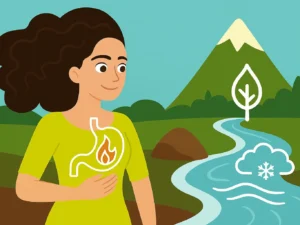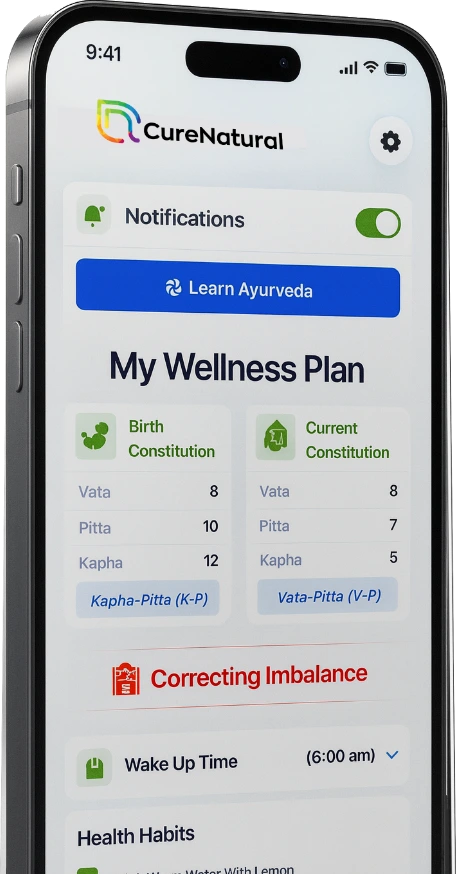- Description
- Curriculum
- FAQ
- Notice
- Reviews
Ayurveda Elements Course: Mastering the Wisdom of the 5 Ayurvedic Elements
Ayurveda, the ancient science of life, teaches that true health begins with balance. At the heart of this wisdom lie the Ayurveda Elements—Earth, Water, Fire, Air, and Ether. These five Ayurvedic elements are not abstract concepts; they shape your body, mind, and emotions. Understanding how they combine to form the Ayurvedic Doshas (Vata, Pitta, and Kapha) gives you the keys to prevent imbalance, restore harmony, and live with vitality.
This Elemental Ayurveda Course is a complete journey into the foundations of Ayurvedic healing. Step by step, you will learn how the Ayurveda five elements weave through your constitution, how imbalances begin, and how food, taste, and lifestyle can become your most powerful medicines.
What You’ll Learn About Ayurveda Elements
1. Ayurveda Five Elements
Explore how Earth, Water, Fire, Air, and Ether form the building blocks of both the universe and your own body.
Learn their qualities, physical roles, and energetic effects. For example, Fire governs digestion and transformation, while Earth provides stability and structure.
2. The Three Ayurveda Doshas: Vata, Pitta, and Kapha
Understand how combinations of the 5 Ayurvedic elements create the Ayurvedic Doshas.
Discover how Vata (Air + Ether), Pitta (Fire + Water), and Kapha (Water + Earth) shape your body type, personality, and tendencies.
Recognize early signs of imbalance and what they mean for your health.
3. Constitution vs. Imbalance
Differentiate between your birth constitution (Prakriti) and your current constitution (Vikruti).
Learn why most online dosha tests miss this critical point, and why healing requires aligning both.
4. The Six Tastes in Ayurveda
Discover how Sweet, Sour, Salty, Pungent, Bitter, and Astringent tastes are made up of elemental combinations.
See how each taste can either balance or aggravate your dosha.
Apply this knowledge to everyday food choices for natural healing.
5. Elemental Zones of the Body
Learn how each dosha dominates a zone: Kapha in the chest, Pitta in the abdomen, Vata in the lower body.
- Learn how shift in the doshas, or the 5 ayurvedic elements, result in health issues and disease if not restored to normal status
See how movement of doshas from one zone to another triggers symptoms like skin inflammation, insomnia, or digestive upset.
6. Correcting Imbalances Through Ayurveda Diet
Apply the principle “Let food be thy medicine.”
Learn how dietary recommendations change as imbalances progress—from simple Kapha congestion to complex tridoshic disorders.
See how tastes, preparation methods, and food combinations restore balance.
7. Synergistic vs. Opposite Effects
Understand how foods and herbs can work synergistically to amplify healing, or create opposite effects that cancel each other out.
Practical examples: Ashwagandha reducing Vata when paired with grounding foods, or Guggul reducing Kapha when combined with detoxifying vegetables.
8. Beneficial vs. Non-Beneficial Preparation
Discover why the same food can heal or harm depending on preparation.
Example: steamed broccoli reduces Pitta, but fried with chilies it aggravates Pitta.
9. Putting It All Together
Compare food qualities (light vs. heavy, warm vs. cold, moist vs. dry) to make personalized decisions.
Use the framework of Ayurveda Elements and Ayurvedic Doshas to understand not just what to eat, but how and when to eat it.
✨ Why Enroll in This Course?
By the end of this program, you will:
Understand the Ayurveda five elements and how they shape your unique constitution.
Recognize early signs of imbalance before they develop into chronic disease.
Apply the principles of taste, synergy, and preparation to use food as daily medicine.
Gain the tools to balance Ayurvedic Doshas naturally—without confusion or guesswork.
This course is not just theory—it’s a practical guide to living in rhythm with nature. Whether you are new to Ayurveda or deepening your studies, you will walk away empowered to take charge of your health.
🌿 Join the Journey
The Elemental Ayurveda Course gives you timeless tools to understand yourself, prevent disease, and restore harmony. By mastering the 5 Ayurvedic Elements and the dynamics of the Ayurveda Doshas, you will unlock a lifelong foundation for health and wellness.
Are you ready to align your body, mind, and spirit with nature’s wisdom?
👉 Enroll today and let the Ayurveda Elements guide you to balance, vitality, and wholeness.
Our other courses are: Mastering Ayurveda Digestion, Kapha Dosha Management, Pitta Dosha Management, and Vata Dosha Management
Introduction
- 1About Ayurveda, and the 4 Paths within Ayurveda
About Ayurveda
This lesson introduces you to the essentials about Ayurveda—the ancient science of life and balance. Ayurveda, which literally means “life knowledge,” teaches how to live in harmony with nature. Through clear explanations and real-life examples, you’ll discover the five elements of life, the three Doshas, and how subtle changes in their balance influence health and vitality.
You will also learn about Ayurveda’s practical side: how food, daily routines, and small lifestyle habits can act as natural medicine. Simple choices—such as eating warm, seasonal meals or following regular sleep cycles—help restore energy and create lasting balance.
Next, the lesson explores the different paths within Ayurveda. The traditional Indian approach focuses on aligning body and mind with nature to prevent disease. The Western approach adapts these same principles to modern nutrition, herbs, and supplements. Meanwhile, advanced paths such as the Sattvic and Yogic diets aim to enhance mental clarity and spiritual awareness.
By the end, you will understand what makes this wisdom timeless. Studying about Ayurveda gives you a practical roadmap to better health, renewed vitality, and a peaceful mind that stays balanced through every season of life.
- 2Ayurveda PathsQuiz for Ayurveda Paths
The Elements and Doshas (body types)
- 3Ayurveda Elements, Doshas and Tastes: The Foundation of Health Balance
Ayurveda Elements, Doshas and Tastes: The Foundation of Health Balance
Ayurveda teaches that true health begins with understanding the relationship between the five Ayurveda elements—Ether, Air, Fire, Water, and Earth—and the body’s natural constitution. These elements combine to create the three primary Ayurveda doshas: Vata, Pitta, and Kapha.
Each Ayurveda dosha represents not only a body type but also the energetic qualities that influence how we think, feel, and respond to the world. For instance, Vata reflects movement and creativity, Pitta represents transformation and digestion, while Kapha provides stability and strength.
The six tastes of Ayurveda—sweet, sour, salty, pungent, bitter, and astringent—are also rooted in the Ayurveda elements and directly affect the doshas. By choosing foods with the right tastes, we can restore balance in both body and mind. Understanding this essential framework of Ayurveda elements and Ayurveda doshas is the first step toward using food as medicine and living in harmony with nature.
- 4Ayurveda 5 Elements: How Elemental Qualities Help us Determine Own Nature
Ayurveda 5 Elements and the Foundation of Health
This course introduces the foundation of Ayurveda through the study of the Ayurveda 5 elements, also known as the Ayurveda Five Elements—Ether, Air, Fire, Water, and Earth.
These five elements are considered the building blocks of both nature and the human body. Together, they shape physical structure, emotional tendencies, and overall health.
In Ayurveda, the Ayurveda 5 elements combine to form the three doshas—Vata, Pitta, and Kapha. Each person’s unique constitution is defined by the balance of these doshas. When that balance shifts, the elements become disturbed, leading to imbalance and disease.
By understanding the Ayurveda 5 elements, you will learn how imbalance disrupts harmony while balance supports vitality, clarity, and longevity. The course also demonstrates how food, environment, and daily habits continuously influence these elements.
You will explore how the guiding Ayurvedic principle—“like increases like, and opposites bring balance”—can help restore health through mindful choices.
By the end of this lesson, you will gain a clear understanding of the Ayurveda 5 elements and how they form the basis for personalized healing, natural balance, and long-term wellness.
- 5Elements and Constitution QuizElements and Body Constitution Quiz
Correcting Imbalances
- 6The 6 Tastes of Ayurveda: How Tastes Help Manage Elements and Doshas
This lesson introduces the 6 tastes of Ayurveda—sweet, sour, salty, pungent, bitter, and astringent—and explains how each taste shapes health and balance. Formed by combinations of the five elements, these tastes influence the three doshas—Vata, Pitta, and Kapha—in unique ways.
You’ll learn how taste becomes a form of medicine: sweet taste nourishes, pungent clears stagnation, and bitter purifies. When used wisely, the six tastes bring energy, clarity, and harmony; when misused, they create imbalance.
By the end, you’ll understand how to combine the 6 tastes of Ayurveda in your meals to align food with your body’s needs—transforming everyday eating into a simple, powerful path to healing.
- 7Ayurveda Dosha Zones: The Hidden Map of Dosha Imbalance
Ayurveda Dosha Zones: The Hidden Map of Dosha Imbalance
Have you ever wondered why certain health issues always seem to appear in the same part of your body—like congestion in the chest, burning in the stomach, or tension in the lower back?
According to Ayurveda, these patterns are not random. They follow a hidden map of dosha zones that reveal where energy—and imbalance—lives in your body.Each of the three zones—Kapha, Pitta, and Vata—governs specific organs, elements, and emotions. When one zone overflows into another, a dosha imbalance begins to form. What starts as a small irritation in one area can gradually spread, influencing digestion, mood, and even immunity.
In this lesson, you’ll uncover how each zone operates, how to recognize early signs of dosha imbalance, and how balance can be restored through food, breath, and awareness. You’ll also see why understanding these zones is one of the most powerful keys to preventing illness before it begins.
Join us to explore the body’s internal landscape—the Ayurvedic way—and discover how mapping your dosha imbalance can transform the way you see health, energy, and healing.
- 8Let Food Be Thy Medicine: The Ayurvedic Way- An Example Using Kapha Dosha Imbalance
Let Food Be Thy Medicine: The Ayurvedic Way- An Example Using Kapha Dosha Imbalance
Ayurveda teaches a timeless truth—food is medicine when chosen with awareness. Every meal we eat has the power to create balance or disturbance within the body. Each dosha—Vata, Pitta, and Kapha—responds differently to taste, texture, and temperature, which is why one person’s superfood can be another’s cause of fatigue.
Take Kapha dosha imbalance, for example. When Kapha becomes excessive, the body feels heavy, slow, and congested. Light, warm, and gently spiced meals can awaken the system, clear stagnation, and reignite vitality. The same logic applies to the other doshas: when Pitta overheats, cooling foods calm the fire; when Vata becomes restless, grounding meals restore steadiness.
In this lesson, you’ll learn how to recognize your unique constitution and detect subtle signs of imbalance before they grow. You’ll see how to use food—not pills—as your first and most reliable form of healing. Ayurveda reminds us that transformation begins not in a clinic, but in the kitchen. Every ingredient holds potential medicine—waiting for you to use it with purpose and wisdom.
- 9Correcting Imbalances QuizCorrecting Dosha Imbalances Quiz
Summary
- 11Summary: Elemental Ayurveda, the 5 Elements, Doshas and Tastes
Summary of Elemental Ayurveda: Understanding Your Ayurveda Constitution
This course introduced the core principles of Elemental Ayurveda—how the five elements combine to form your unique Ayurveda constitution. You’ll explore how the doshas, tastes, and body zones interact to shape health and imbalance. Through practical insights on food as medicine, elemental balance, and the power of synergy and opposition, you’ll gain the foundation to restore harmony and apply Ayurveda in everyday life.
- 12Final Elemental Ayurveda QuizElemental Ayurveda Final Quiz
Ayurveda Elements: Mastering the Wisdom of the 5 Ayurvedic Elements
Course Overview
Ayurveda teaches that all health and disease begin with balance—or imbalance—of the five elements: Earth, Water, Fire, Air, and Ether. These elements shape your body, mind, and emotions, combining to form the three doshas—Vata, Pitta, and Kapha. This course gives you a practical foundation to understand how elements weave through your constitution and how to restore harmony when imbalance occurs.
What You’ll Learn
- The five elements of Ayurveda, their qualities, and how they express in body and mind
- How doshas (Vata, Pitta, Kapha) arise from element combinations and define your constitution
- The difference between Prakriti (birth constitution) and Vikruti (current state of imbalance)
- The six tastes and how they balance or aggravate different doshas
- Elemental zones of the body and how doshas move to create symptoms
- Correcting imbalances through food, taste, and lifestyle adjustments
- The impact of synergistic vs. opposing food/herb effects
- Why preparation methods change whether food heals or harms
- How to put it all together into a personalized system of balance
Who This Course Is For
- Beginners seeking a clear, structured introduction to Ayurveda
- Practitioners who want to strengthen their foundations and refine client guidance
- Anyone who wants to use food, taste, and lifestyle as daily medicine for balance and prevention
Why Enroll
By the end, you’ll:
- Understand how the five elements shape your unique nature
- Recognize early signs of imbalance before disease takes root
- Apply the principles of taste, synergy, and preparation to your meals
- Confidently use Ayurveda to prevent, correct, and manage imbalances
Your Takeaway
This course is a practical guide to living in rhythm with nature. You’ll leave with timeless tools to understand yourself, restore harmony, and unlock lasting vitality through the wisdom of the elements.








